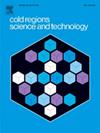Experimental study on the influence of the warm-humid climate environment on the water and salt migration (WSM) and deformation of sulfate saline soil
IF 3.8
2区 工程技术
Q1 ENGINEERING, CIVIL
引用次数: 0
Abstract
To clarify the influence of the warm-humid climate environment on the water and salt migration (WSM) and deformation of saline soil, the climatic environment characteristics and saline soil types (sulfate saline soil) in the Hexi region of Gansu Province were taken as the background. Combined with the surface energy budget balance characteristics for the first time, the coupling change characteristics of various physical fields within the sulfate saline soil under the normal temperature, single heating effect, and warm-humid conditions were studied. Moreover, the development process of salt crust and cracks in saline soil was clarified. The results show that the single heating effect results in increased upward shortwave radiation, upward longwave radiation, and downward longwave radiation compared to the normal temperature, as well as decreased surface net radiation. Compared to the single heating effect, the warm-humid environment has little effect on upward longwave radiation, yet it reduces upward shortwave radiation and downward longwave radiation. Additionally, the single heating effect results in an overall low soil water content and conductivity, along with a high soil temperature. However, the warm-humid environment will increase the soil water content and conductivity, and reduce the shallow soil temperature. Moreover, the shallow soil temperature in the warm-humid climate environment is between the normal temperature and single heating effect. The total deformation of saline soil caused by the warm-humid environment is between the normal temperature and single heating effect. Meanwhile, the warm-humid environment will accelerate the development of salt crust and cracks of sulfate saline soil. The results can provide technical support for the engineering application and soil salinization management in salted regions under the warm-humid climate environment.
暖湿气候环境对硫酸盐盐渍土水盐迁移及变形影响的实验研究
为明确暖湿气候环境对盐渍土水盐迁移(WSM)和变形的影响,以甘肃河西地区气候环境特征和盐渍土类型(硫酸盐盐渍土)为背景。首次结合地表能量收支平衡特征,研究了常温、单一加热效应和暖湿条件下硫酸盐盐渍土内部各物理场的耦合变化特征。阐明了盐渍土中盐壳和裂缝的发育过程。结果表明:与常温相比,单次加热作用使地表短波辐射上升、长波辐射上升、长波辐射下降,地表净辐射下降;相对于单一的加热效应,暖湿环境对向上的长波辐射影响不大,但对向上的短波辐射和向下的长波辐射有一定的抑制作用。此外,单一的加热效应导致土壤含水量和电导率总体较低,同时土壤温度较高。然而,温暖潮湿的环境会增加土壤含水量和电导率,降低浅层土壤温度。暖湿气候环境下浅层土壤温度介于常温和单一加热效应之间。暖湿环境引起的盐渍土变形总量介于常温和单一加热作用之间。同时,温暖湿润的环境会加速硫酸盐盐渍土的盐壳和裂缝的发育。研究结果可为暖湿气候环境下盐渍地区的工程应用和土壤盐渍化管理提供技术支持。
本文章由计算机程序翻译,如有差异,请以英文原文为准。
求助全文
约1分钟内获得全文
求助全文
来源期刊

Cold Regions Science and Technology
工程技术-地球科学综合
CiteScore
7.40
自引率
12.20%
发文量
209
审稿时长
4.9 months
期刊介绍:
Cold Regions Science and Technology is an international journal dealing with the science and technical problems of cold environments in both the polar regions and more temperate locations. It includes fundamental aspects of cryospheric sciences which have applications for cold regions problems as well as engineering topics which relate to the cryosphere.
Emphasis is given to applied science with broad coverage of the physical and mechanical aspects of ice (including glaciers and sea ice), snow and snow avalanches, ice-water systems, ice-bonded soils and permafrost.
Relevant aspects of Earth science, materials science, offshore and river ice engineering are also of primary interest. These include icing of ships and structures as well as trafficability in cold environments. Technological advances for cold regions in research, development, and engineering practice are relevant to the journal. Theoretical papers must include a detailed discussion of the potential application of the theory to address cold regions problems. The journal serves a wide range of specialists, providing a medium for interdisciplinary communication and a convenient source of reference.
 求助内容:
求助内容: 应助结果提醒方式:
应助结果提醒方式:


